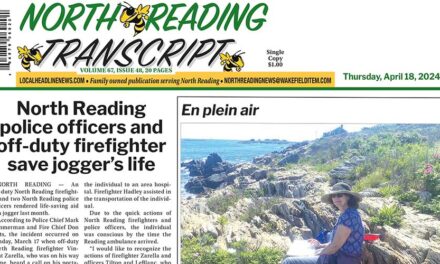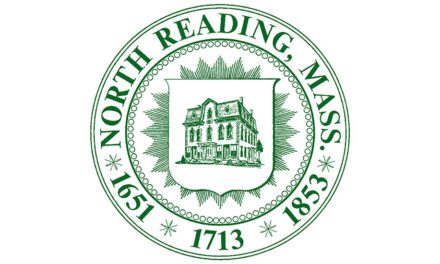Published in the May 19, 2016 edition
By BOB TUROSZ
NORTH READING – In just two and a half weeks, Town Meeting will be asked to vote on North Reading’s plan to join the MWRA district for water supply by 2019.
Town officials held a dry run (no pun intended) of their Town Meeting presentation last week in the High School’s Distance Learning Lab. Billed as a workshop, it was probably a fairly accurate prequel of what’s in store for Town Meeting on June 6, although on a smaller scale. There were some people in favor and some people opposed. Some people were skeptical and there were a whole lot of technical questions.
In addition to the North Reading Selectmen and town officials, the meeting was attended by numerous Reading officials, including a majority of their Selectmen, their town manager, DPW Director and assistant director and support personnel as well as State Senator Bruce Tarr. Also on hand were MWRA Executive Director Fred Laskey and Pamela Heidell, MWRA planning manager and others.
The town is at a crossroads regarding its long term water supply. The choice is to join the MWRA, which can supply 100 percent of North Reading’s water supply well into the far future or stay with North Reading’s existing infrastructure which needs expensive upgrades and will still require the town to purchase most of its water from Andover.
According to a chart presented at the meeting, both alternatives have pros and cons:
Staying with the town’s existing water supply infrastructure:
Insufficient capacity that cannot be increased.
$9.6 million investment required over the next five years.
Cannot support growth of town.
Future Andover water rates unknown.
Major regulatory risk due to stressed nature of the Ipswich River.
Increased manpower and operating and maintenance costs.
Switch to MWRA:
Nearly unlimited capacity to provide 100 percent of the town’s water supply needs.
“Buy-in” cost for North Reading of $7.68 million and $9.9 million in capital expenditures required.
Satisfies town’s future needs for growth and water supply.
Not dependent on Andover
Minor, if any regulatory risks
Reduced labor and operating expenses, about $300,000
Water supply needed
At the present time, the town operates fewer than half a dozen groundwater wells, two treatment plants and one booster station, “a fairly complex system,” according to consultant Rob Williamson. The problem is, because of their age and deterioration, those wells can only produce 60 percent of what they were originally designed for. North Reading purchases two-thirds of its daily water supply from Andover. And especially in the summer, when peak demand is high, there is a water supply deficit of about 350,000 gallons per day. This is projected to grow to 370,000 gallons a day in the future, which will severely limit the town’s growth.
Andover is not a viable option for increased water supply to make up that deficit, according to Williamson and town officials. Andover is limited to supplying North Reading 1.5 million gallons per day (the amount it already supplies) and even the best conservation efforts North Reading can put in place won’t make up for the deficit.
And North Reading can’t make up the difference by pumping more from its own wells or drilling new wells. The town was strictly limited by the state decades ago in the amount of water it can pump from the Ipswich River water basin because the Ipswich is listed as one of the most stressed rivers in the country.
The MWRA, on the other hand, has excess water capacity, redundancy capability and Reading has a strong water pipe network capable of pushing water through to North Reading.
The recommended plan
That’s why the recommended plan is for MWRA to supply water to North Reading through Reading through 2 ½ miles of pipe upgrades in Reading and a booster pump station in North Reading in the vicinity of Mill Street.
North Reading would maintain its connection to Andover, which could be used as an emergency backup. This would also benefit Reading, because that could also serve as Reading’s backup in the event of an emergency. North Reading would then be able to shut down its existing wells and treatment plant facilities.
If all goes well and that includes positive action by Town Meeting on June 6, North Reading would connect to the MWRA for water supply by 2019.
Water or tax rate impact
There’s a couple of ways to pay for the estimated $10 million construction portion of the project – either through the tax rate or on the water rate. Town Administrator Michael Gilleberto said if the cost is transferred to the tax rate, it would add about 22 cents to the rate, and the cost to an average single family home valued at $502,000 would be $109 per year.
The advantage to putting it on the tax rate is that tax bills are deductible on one’s federal income tax whereas the water bills are not. It the costs are kept on the water rate based on consumption, the total cost would be $189 on the water bill of a “medium” water user – someone who uses 90,000 gallons per year. This accounts for most of the town’s water users.
Although putting the $10 million in construction costs on the tax rate would allow folks to deduct it on their tax bill, of those who spoke at the meeting, people favored putting it on the water rate based on consumption.
“While personally, it might be best for me to have it on the tax rate, I feel it’s fairest to have it based on usage. It’s incumbent on families to decide how much water they’re going to use. And for older people or single people, it helps them,” said Marci Bailey of Duane Drive.
A resident from Northridge Drive spoke at length against the MWRA project, saying the town would lose control of its destiny by joining the MWRA and that it’s not a good business deal for the town
MWRA Executive Director Laskey replied that for a $307,000 annual buy-in cost, North Reading will be joining one of the finest water systems in the country, a massive water reservoir in the western part of the state and state of the art water treatment plants. In addition, MWRA will be providing the town with zero percent financing on the capital costs.
“Your local water system will remain autonomous. We are the wholesalers, you are the retailers,” Laskey said.
The final decision, which will affect the town’s water supply quality and quantity and potential for future economic growth for decades to come will be made Monday, June 6 at Town Meeting.




